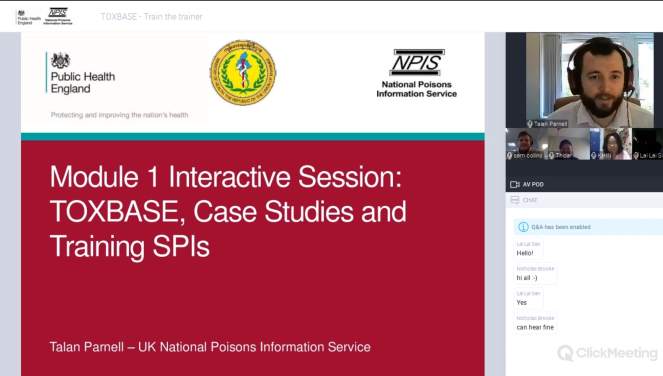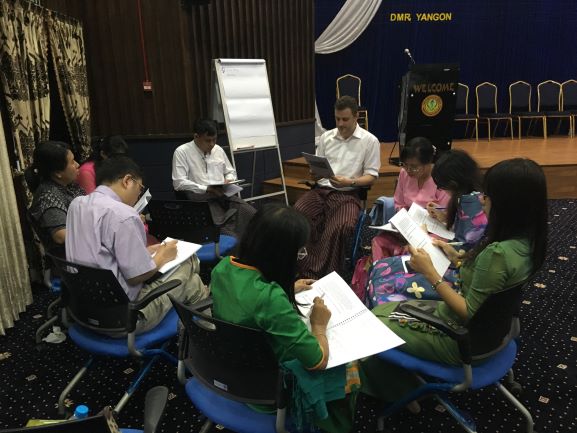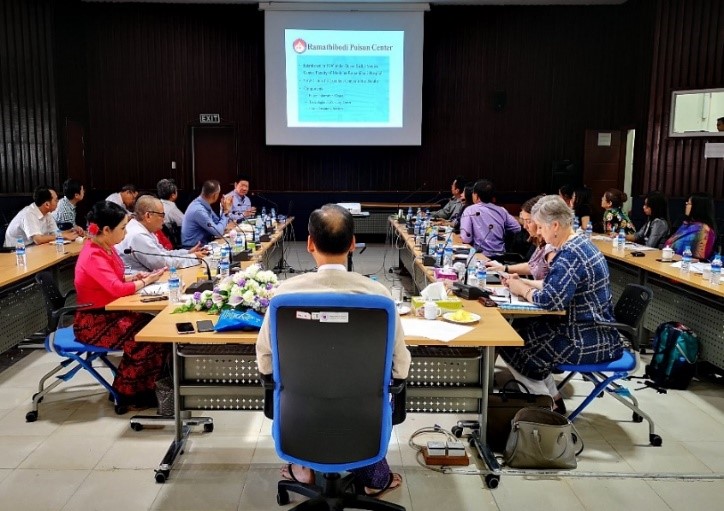
KEY ACHIEVEMENTS | BACKGROUND | PRACTICE DEVELOPMENT | RESULTS | KEY LEARNINGS
Key achievementsPHE’s chemical events work in Myanmar has focussed on the following areas:
|
Background
PHE’s work within the context of the International Health Regulations (IHR) and chemical events aims to develop and strengthen systems for the detection, assessment and response to chemical health threats. Myanmar scored a “1” for both chemical events indicators in the WHO Joint External Evaluation (JEE), indicating no capacity for the prevention, detection or response to chemical events. Scoping visits in 2018 identified opportunities to strengthen Myanmar’s chemical systems in line with the JEE priorities. One of these priorities is the strengthening of the national poisons system including access to poisoning resources, development of standard operating procedures, provision of training to the National Poison Control Centre (NPCC), standardisation and harmonisation of poisoning activities between different stakeholders and enhancement of clinical toxicology capacity.
Practice development
 TOXBASE® is the primary clinical toxicology database of the UK National Poisons Information Service and a first-line resource for poisoning information. Through the IHR Project, learning and knowledge management on poisons has been enhanced through TOXBASE access for NPCC and Poison Treatment Units (PTU) at the New Yangon General Hospital (NYGH), Mandalay and Magway General Hospitals. Delivery of TOXBASE® courses have taken place at the National Poison Control Centre and a call recording poisons database has been established.
TOXBASE® is the primary clinical toxicology database of the UK National Poisons Information Service and a first-line resource for poisoning information. Through the IHR Project, learning and knowledge management on poisons has been enhanced through TOXBASE access for NPCC and Poison Treatment Units (PTU) at the New Yangon General Hospital (NYGH), Mandalay and Magway General Hospitals. Delivery of TOXBASE® courses have taken place at the National Poison Control Centre and a call recording poisons database has been established.
The enhanced detection and surveillance capacity of incidents involving poisons has been strengthened through the delivery of training on Chemical Threats, Poisoning Epidemiology and Environmental Epidemiology to NPCC and Occupational and Environmental Health Division (OEHD). The IHR Project team also facilitated the delivery of a chemicals/toxicology laboratory gap and needs analysis and delivery of analytical method development workshop to NPCC colleagues. Through IHR Project activity, clinical toxicology capability and capacity strengthening for the management of human poisoning cases has been achieved through gap and needs analysis engagement with clinicians from NYGH, Yangon General Hospital and Mandalay General Hospitals, as well as provision of access to free distance-learning courses to health worker staff at these units.
The IHR Project also successfully led the facilitation of the first roundtable meeting on poisoning in collaboration with WHO Myanmar office. This meeting in turn facilitated antidote selection for the iCAPS program, demonstrating our activity to engage with national as well as international global health security stakeholders on management of chemical and poisons.
Results
The IHR Project’s partnership with NPCC on strengthening national poisons and chemicals management capability and capacity has resulted in 41 healthcare staff, based at Mandalay and Magway General Hospitals, undertaking essential TOXBASE® e-learning. In addition, the Project’s engagement activities have promoted enhanced co-creation and collaboration with national stakeholders on poisons and chemicals management, including WHO Myanmar office, Occupational and Environmental Health Division from the University of Public Health, NPCC and NYGH, Mandalay and Magway General Hospitals.
Key Learning
The COVID-19 pandemic resulted in lengthy international travel restrictions, so the IHR Project team quickly adapted program plans and shifted to remote delivery. A virtual platform that could facilitate the delivery of technical material was identified and training was tailored in order to suit distance learning needs. The training course was a mixture of pre-recorded lectures, interactive live sessions and quizzes. Coursework included content on some of the top causes of poisoning in Myanmar, a refresher on how to access and interpret toxicological information, as well as softer skills such as call handling and communicating recommendations to medical practitioners who phone the centre. Multiple choice questionnaires used throughout the course demonstrated that engagement with the material increased trainee knowledge on poisoning and competency in poison centre operations. Follow-up modules will build on this work, providing more content on other causes of poisoning and facilitating development of Myanmar-specific operating models while drawing upon UK experience.
Ultimately, a key role for PHE is to share our understanding of the importance of multi-sectoral engagement and to help our Myanmar partners bring stakeholders together to efficiently and effectively put into place structure and arrangements to strengthen their current capacity with respect to poisoning. Continually embedding these objectives in all facets of the program also ensures the sustainability of the work we champion. Indeed, train-the-trainer coursework and technical content provided by the distance learning course are already being disseminated by partners to other professionals in-country and generating interest for future partnership work locally. Engagement with international stakeholders is also an important aspect woven into our work. Opportunities to work in a transparent and collaborative way with partners such as the World Health Organization (at international, regional and national levels) are also sought throughout the implementation of the project. Ultimately our collaborations will result in outputs that can be owned by Myanmar and sustained in the future.


Figure 3a – First roundtable meeting on Human Poisoning and 3b- participants from the Department of Medical Research, Occupational and Environmental Health Department and NYGH undertake an environmental epidemiology exercise during an interactive workshop
KEY ACHIEVEMENTS | BACKGROUND | PRACTICE DEVELOPMENT | RESULTS | KEY LEARNINGS